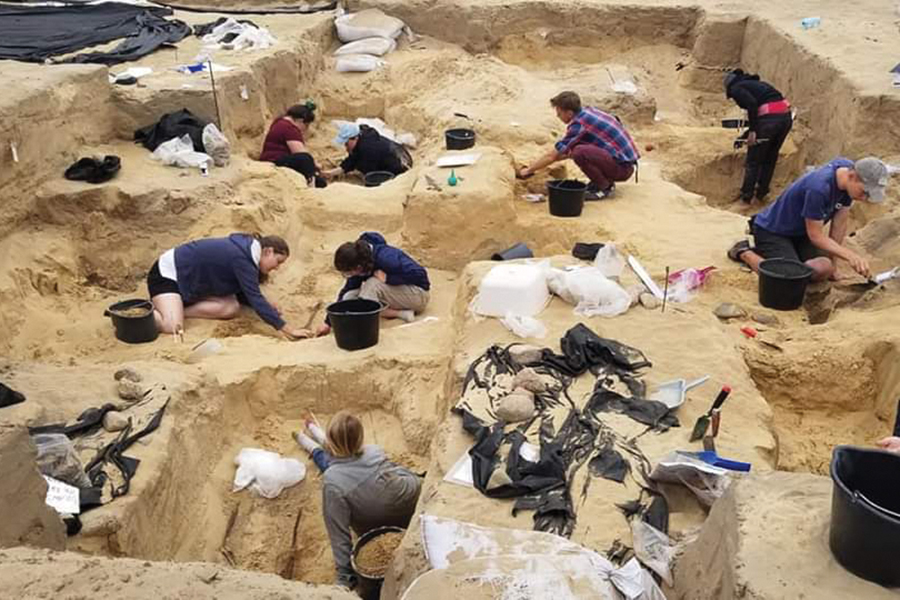
Part three of a continuing series about experiences on an archeological dig in Poland
Sold in nearly every store this time of year, fake skeletons are a staple Halloween decoration. Unsurprisingly, these decorations are not very anatomically accurate and commonly leave out bones, fuse unrelated bones together and miss many other important features of our bones. Over our lifetime, our bones change shape and develop features that can be used to identify us.
This summer I participated in the Slavia Foundation’s archaeological field school. We
excavated both Bronze Age (IV and V Period) cremations and Early Modern (16th -18th century) inhumation burials. These inhumation burials included a coffin that was buried deep in the ground. Once the Early Modern burials were excavated, we examined the skeletons for features that would tell us more about them. For example, features on the pelvis (hips) and cranium (skull) can help determine the sex of an individual.
“I like looking at sex estimation because it is the easiest one, because you can look at the pelvis and specific cranial features,” said Tiffany Loera, a student at the field school. “Also kid’s skeletons are interesting because they don’t have those features unless they hit puberty.”
As juveniles, our bones are not fully formed. When we grow older, many of our bones fuse, including those in our arms and legs. Interestingly enough, if juveniles contract a disease that affects bones, the effects of it can still be seen when they are adults.
“You can see rickets, that’s also a bowing of the tibia [leg bones bending, syphilis also does this], but there’s a way to tell the difference,” said Ashley Stewart the field osteologist. “There’s this like line on the side, and if it bows it’s rickets, and if it’s straight it’s syphilis. You can see stuff that happened as a kid sometimes, but kids heal really well because their bones, we call it ‘green bone’, because they recover really quickly. So like if you break something as a kid and it sets well, you probably won’t notice.”
Certain skeletal parts can also be used to determine how healthy the person was. For example linear enamel hypoplasia, a condition in which teeth have bumps on them, usually indicates a poor diet or unfavorable environmental and living conditions.
“On the skeleton, you can see some parts of it, for example on the skull, you can see some marks which explain how somebody lived,” said Marta Gwizdala, the project osteologist. “For example, if there were good healthy conditions, if it was maybe not clean…about diet, some kinds of parasites.”
Those that do a lot of physical activity may have more ‘rough patches’ on their bones for muscles to attach. Other diseases such as arthritis, degenerative bone disease and tuberculosis can also be seen on skeletons. One fascinating albeit morbid area is exploring the effects of advanced diseases and trauma on bones.
At the field school, the most remarkable example of this was “skeleton number 39”. Somehow, this person endured trauma to their hip, which resulted in their upper leg bone completely fusing to the pelvis. Not only was their leg sticking straight out in an unmovable position but they lived for quite some time after this happened in 16th-18th century Poland.
“The femur and acetabulum are fused together,” said Victoria Swenson, the osteology instructor. “I want to X-ray it because I want to see what it looks like on the inside.”
Cemeteries such as the Drawsko One site are important for archeologists to understand the people who lived during that time. They can tell how healthy a population is, what diseases affected them and how old people were when they died. And for cases like skeleton 39, a paradox is created.
“It’s sad because we go ‘wow this person was so sick’ but then that goes into the osteological paradox… because you only get skeletal changes on things like that after a really long time,” Stewart said. “So it’s like that person had to be really healthy to make it that far, but they were also super sick so it’s like which is it?”
Written by: Rachel Paul— science@theaggie.org



